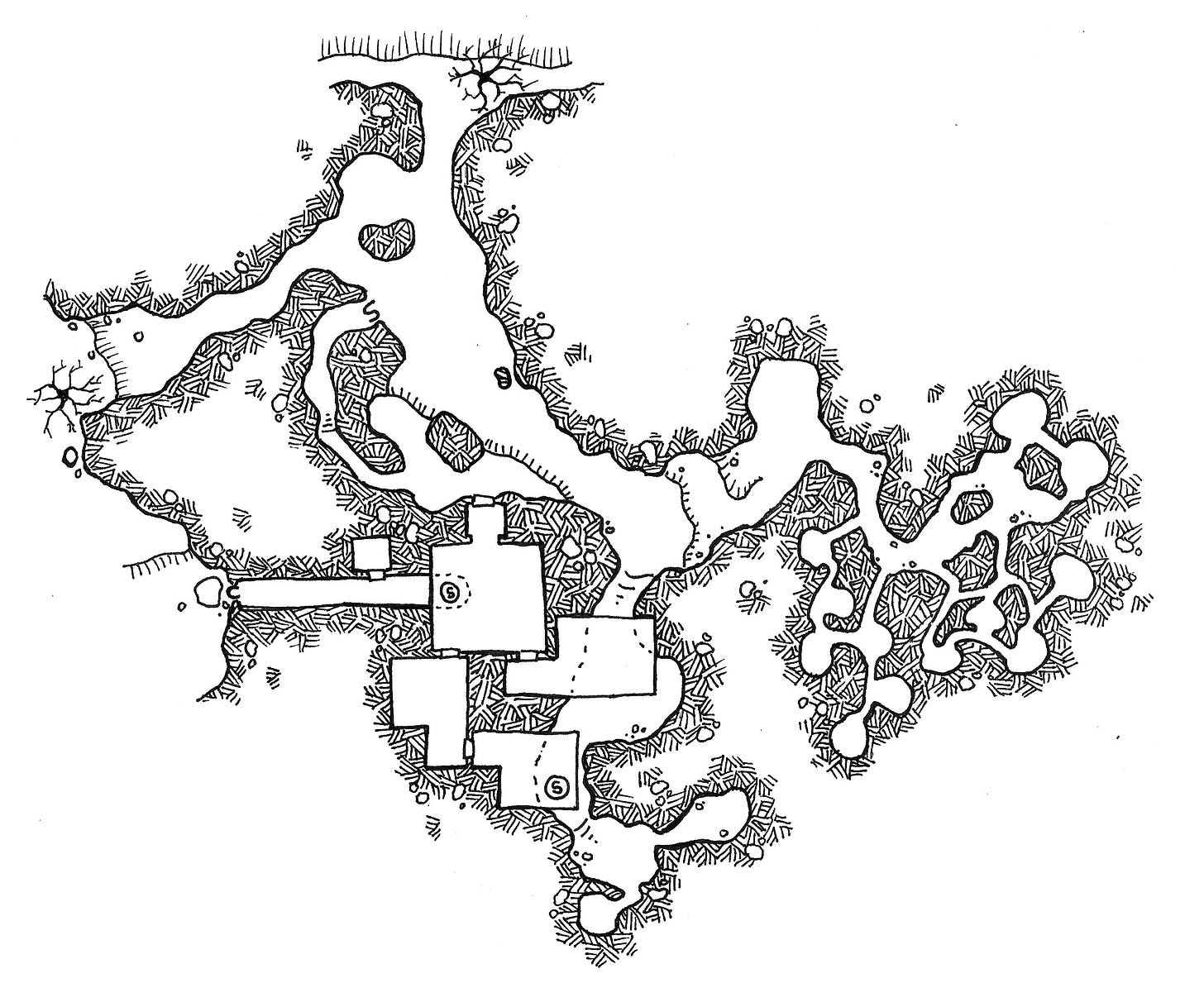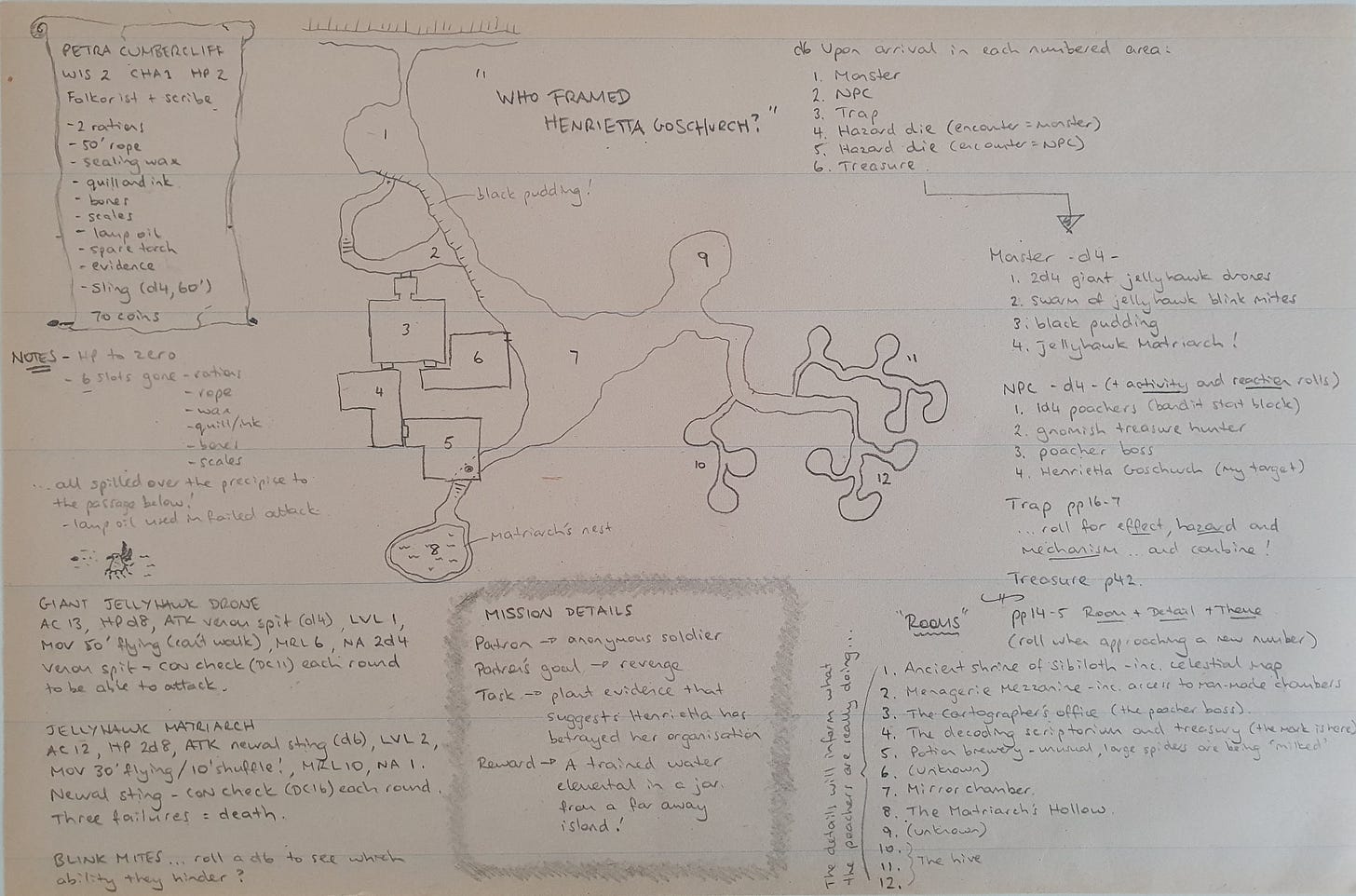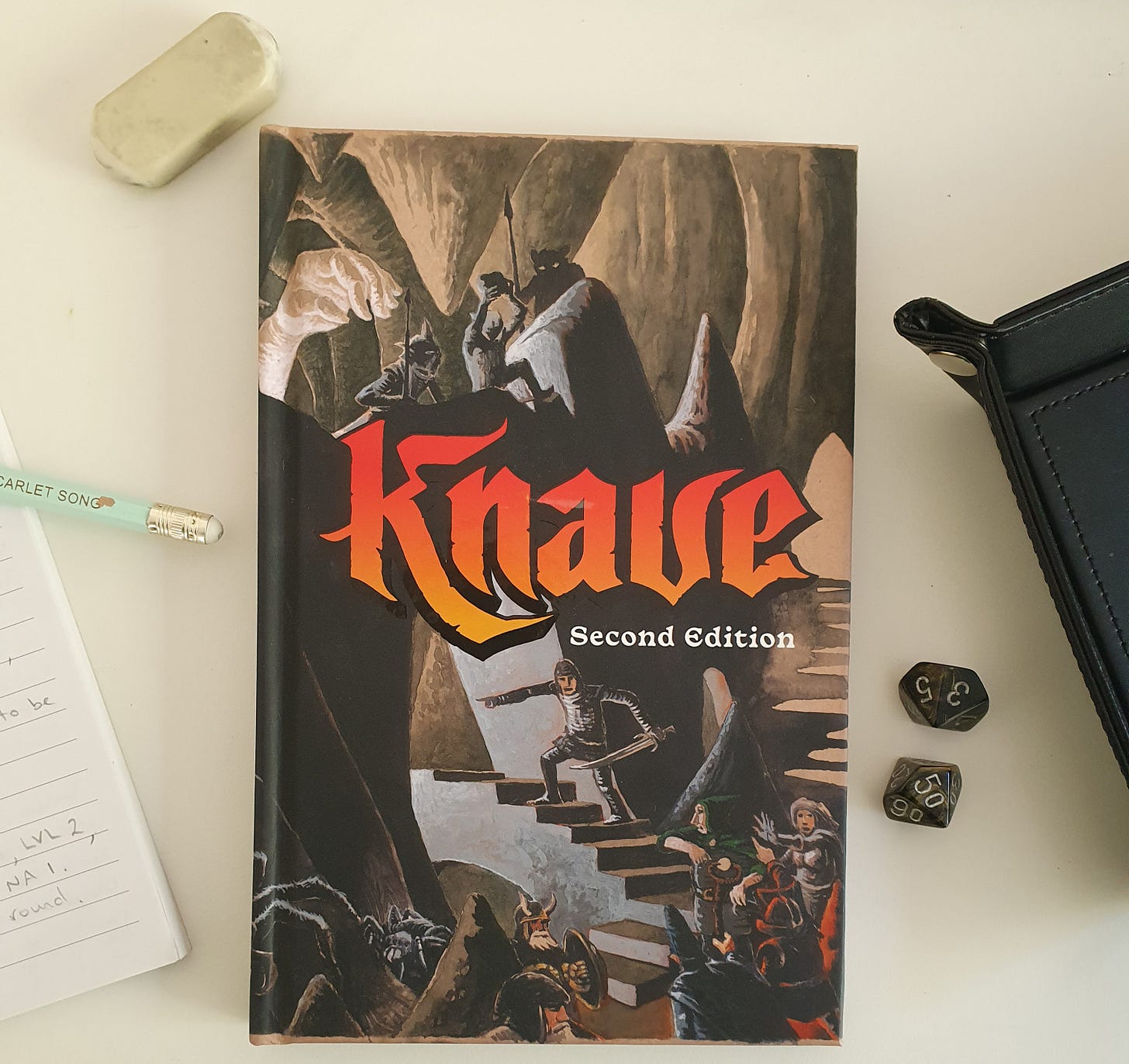THE GAMING TABLE - KNAVE 2e
A behind the screen look at Knave, my solo adventure, and the transition to short story
Welcome to The Gaming Table … and the official launch of A Dungeon Of One’s Own. Every two weeks I will play through a roleplaying game and use that experience to pen a brief tale. Ordinarily this behind the scenes look at the TTRPG system used, and the process of converting my adventure into a story, would be reserved for Founding Members only. To celebrate my official launch I am making this edition available to all!
What a roller coaster ride this one was. I love Knave and the solo play process did not disappoint. I must confess: after the hapless demise of my character in my Cairn adventure, I did try genuinely hard to keep Petra alive this time around. She was absolutely done for, in combat. Since the fighting was happening just outside a closed door, however, I paused and rolled on Knave’s tables to see what might be on the other side of that door, and whether someone might be in there.
As you can see in my notes, I had already rolled to check whether the door was locked (and it was). The decision to break from combat and explore the chances of Petra being "rescued" was the moment when the story truly came alive … so thank goodness I did. But I’m getting ahead of myself. The notes won’t make too much sense until you’ve seen my earlier planning and the rudimentary one-page adventure module I ended up designing.
So let’s go back to the start …
Some of you may have already seen the planning notes above on Discord or here on Substack. This, right here, is the beauty of the endless possibilities that Ben Milton’s Knave: Second Edition provides us. In designing my adventure, I chose to use just a few of the 75 (yes, 75!) d100 tables in the book: dungeons, factions, and missions, to guide me. Immediately I had a quest: head into an insect hive, currently the headquarters of some poachers, wherein I would find a person I needed to frame. I then rolled on rewards to see what I would be getting in return and, most importantly, what creatures might inhabit the hive. As you can see, I ended up devising my own stat blocks for these unique monsters (jellyhawks!) which, it’s fair to say, have never appeared in any other fantasy adventure ever!
At this point, I needed a map. Unlike my Cairn adventure, where one of that system’s strengths lies in designing your own map, Knave is built with the classic dungeon crawl framework in mind. The strength of Knave is the opportunity to combine dice rolls from your choice of its 75 tables to let the dungeon and story reveal themselves, room by room. To facilitate this I needed someone better than me at making dungeon maps. The number one resource I turn to (and highly recommend) for maps is the Dyson Logos blog. Dyson Logos maps are beautiful and adaptable, and you will almost always find something suitable for your adventure. I simply searched for "insect hive" on the Dyson Logos website and found what I was looking for straight away.
Dyson Logos map: The Hive In Carver’s Cave
So now I had a quest, some horrifying monsters, and the basis of a map … all I really needed to get started was my character. Rolling up a character in Knave is fast and simple. You have three points to distribute among the six abilities common to many familiar TTRPG systems. Roll three 6-sided dice to see where those points land, another d6 for Hit Points, and a couple of d100 rolls on the careers and names tables … and that’s it. Petra Cumbercliff, Folklorist and Scribe, was born! She ended up with a +2 on Wisdom and a +1 on Charisma … and a measly 2 Hit Points. Similar to Cairn, zero HP isn’t dead - in Knave you need to burn through your inventory slots before you’re done.
It wasn’t my original intention to make a single-page adventure module, but once I’d drawn a simplified version of the map onto some paper, it evolved very quickly into just that:
As I was playing solo, and did not want to know what was in each area of the map before I arrived, I devised a very simple dungeon delving process to sit alongside Ben’s mechanic in Knave. I also wanted these rolls to slowly reveal who these "poachers" were and what they were doing here, rather than deciding that in advance. As my character approached a numbered area, I rolled on the rooms, room details, and room themes tables to see what lay ahead. Then, upon arrival in the area, I would roll a d6 to see if I encountered a monster, an NPC (non-player character), a trap, or some treasure, or if I should re-roll on Ben’s d6 delving table (known as the Dungeon Hazard die). The reasoning behind this slight redesign is that I wanted to skew the results toward increasing the chances of encountering the poachers and the monsters, since that was what this dungeon was all about. I also wanted to add the components of traps and treasure, which a Game Master would ordinarily be throwing into the mix for their players, and increase my chances of rolling on more of Ben’s excellent tables.
Once I started using the space around my map to note some of these details, it was obvious that I would be able to find room for a monster table, an NPC table, my character sheet, and basically everything I needed in one place. Just like that, Knave empowers you to create an entire dungeon crawl module, with completely unique creatures and scenarios that self-generate as you play, in a matter of two hours or so. Incredible.
Time for adventure! As Petra approached area 1, I rolled shrine (rooms), torch (room details), and mouths (room themes). I wanted to know who the shrine was for, so I rolled on the domains table and came up with sand. I quickly decided it was a shrine to an ancient desert god called Sibiloth, the god of silence. I imagined an altar with an unlit torch on top and, after I rolled treasure on my dungeon delve die, a hidden scroll containing a celestial map (rolled on the treasures table). And there it was. That’s how easy it is to use Knave to generate a one-of-a-kind dungeon room. As it turns out, I only mentioned the room briefly in the story, but the details discovered here still informed what happened later on.
Next, I gave Petra a one in three chance to notice the secret passage, and she did. For area 2, I rolled menagerie, fireplace, and wine. The description of the mezzanine became less important, however, after I rolled a 1 on my delve die (monster) and then a 1 again, indicating 2d4 giant jellyhawk drones. Fortunately, both d4 rolls were also 1s, meaning only two of the creatures appeared. Though they did, according to the surprise mechanic in Knave, catch Petra unawares. That is why they both got to spit their venom at her (both hitting) before she knew what was happening.
In the spirit of keeping this character alive, I even gave the jellyhawks a one in six chance of not being aggressive. Turns out, they were! Petra subsequently lost the Initiative roll, which meant the drones acted before she did in round one. One of them struck her again and, despite passing her Constitution save to attack her enemies, she missed their Armor Class of 13 by just a single digit in her attempt to fry them in hot oil.
By now Petra had lost her 2 Hit Points and 6 of her inventory slots, meaning she was only 4 damage points from death. As mentioned earlier, I decided at this point to roll to see what was in the next room and whether someone was there whose interest might be piqued by the kerfuffle outside. Thank goodness I did, because the story was basically written for me in those dice rolls. Area 3 turned out to be a map room with a scent of onions, and it contained the boss of the underground operation. From there, the tale began to unfold in my mind.
A couple of Charisma rolls later, and it looked like Petra was being led into a trap, with nowhere to run. This changed everything in terms of gameplay. I stopped rolling my delving die and simply focused on using the tables in Knave to describe what was in the rooms the characters passed through on their "tour." I rolled to see if the target of Petra’s quest was in the scriptorium and, even though she was, Petra never really had the chance to fulfil her mission. By now I could see that she was headed for the Matriarch’s lair - I decided that was where Daegal was leading Petra, since the random encounters were now temporarily out of play.
At this point it seemed logical that Petra would try to escape, ignoring her quest entirely and prioritizing survival. You can see from my notes how the gameplay shifts from mostly rolling dice and recording results, to shaping the meat of the story as I went. You can also see how my handwriting becomes messy and a little frantic once we reached the lair! Having been left by Daegal to die, Petra’s dice rolls improved, and she got the jump on the Matriarch. This meant that, being faster, she could at least get away from the monster that would most certainly have killed her.
A brief glimpse of a black pudding (a classic first and second edition D&D monster) and a panicked moment in a mirror chamber flashed by as Petra made her escape. No success on the quest. No treasure (she left the scroll behind). Most of her gear gone. But she was alive. And she could think twice next time someone she has a fling with tries to coerce her into doing a little "adventuring" for them.
So that’s it. That is how I played solo using Knave and composed a little story. Some folks over on my Discord server have voted on the game I will use for my next story, and it is going to be Fria Ligan’s Vaesen. I am not quite sure yet how I will approach the solo play aspect, but I am sure I will come up with something and I can’t wait to share the results with you all.










